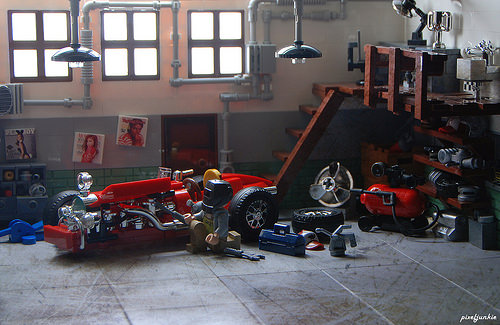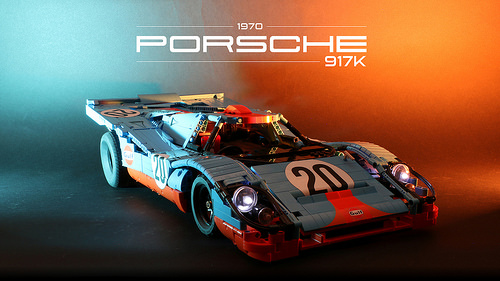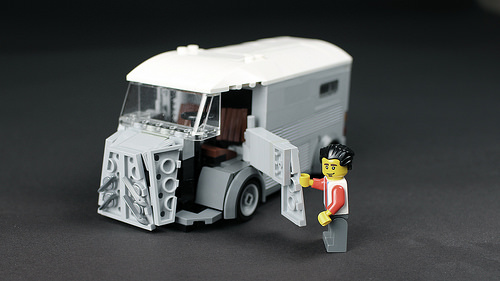Amidst the summer heat, Josephine Monterosso’s brick-built grapes look quite refreshing, not to mention realistic. They look like they were just picked off the vine, right down to the green leaf hanging off the end of the stem (the leaf appears to be a green minifig cape). The grapes themselves are purple Technic ball joints, a part which has been around since 2001 but never appeared in dark purple until this year (you can find it in sets 76103 & 41342). A good part can be made even better with the proper technique, and I especially love how Josephine used plant pieces to create a very organic looking bunch of grapes. Bon appétit!
Posts by Matt Hocker
Maersk Pier is a majestic port that is sure to marvel all
LEGO and storytelling are a match made in heaven. As much as I enjoy building for the sake of building, I also enjoy LEGO as a medium for producing a narrative. Markus Ronge had me hooked last month when he shared a teaser poster for an upcoming series of story-driven steampunk builds. A few days ago, Marcus revealed the first part of his conceptualized world in the form of Maersk Pier, owned and operated by fourth-generation shipping mogul, Herman van de Maersk.
Bored with the shipping industry, Herman decided to build this majestic port to serve luxury airships and their wealthy clientele. As a steampunk model, Maersk Pier is breathtakingly beautiful and does a great job of blending Victorian-style architecture with steampunk fantasy. The extensive use of white works well and reminds me of marble, which witnessed a resurgence in use as a building material during the 19th Century Greek Revival period. Speaking of history, the model’s name is a clever nod to LEGO’s lengthy relationship with the Maersk shipping company, which has included a number of Maersk co-branded LEGO sets over the years.
See lots more photos of this amazing LEGO steampunk diorama
Welcome to a temple with a “killer” view
No matter how strange or limiting a LEGO part may appear to be, there is no such thing as a useless piece. With a little thinking outside the box, it’s sometimes surprising what you’re able to accomplish. Case in point, David Zambito’s microscale “Temple of Tarrasque” takes the LEGO Batman Movie’s Killer Croc minifigure and literally turns him on his side. Killer Croc’s body has been cleverly placed within the model to form a major portion of the mountainside, and the figure’s printed dark green spots are reminiscent of shrubbery. It accentuates an already beautiful landscape filled with a variety of fun angles, and the tiny temple is equally impressive.
From parts car to restored racing legend, this garage has it all.
Over the past few weeks, I have been following Pixeljunkie’s progress on an exciting series of photographs that seemingly depict the restoration of a classic 1950s Mercedes race car. Time and time again, Pixeljunkie has demonstrated an impeccable talent in building minifigure-scale vehicles and setting the scene (like his Bugatti we featured back in July). His latest image depicts a gritty but gorgeous-looking garage, along with his partially stripped down Mercedes race car. Pixeljunkie opted to leave the engine exposed, and it sports a fair amount of detail for being confined within such a small space.
With the extensive repairs out of the way, it’s time to load the car up for transport. The fully restored racer looks simply stunning, and the small team of restorers is just as charming as the car itself. Out of the entire lot, the middle-aged motorhead with cigarette in hand is my favorite (the cigarette itself is an interesting use of three Nanoblock pieces). Several other fun details can be found in Pixeljunkie’s garage, such as a loft area with a drafting table and sink. Meanwhile, shelves are filled with a wide variety of tiny tools.
See the vintage Mercedes racing car in its restored glory
The minifigure turns 40: a colorful history of LEGO’s most beloved characters
Did you know that 2018 marks the 40th anniversary of the modern minifigure? In recognition of this very special birthday, the LEGO Group released its party-themed Series 18 minifigures a few months ago, including a remake of the 1978 policeman. The LEGO Group continues to celebrate, this time by reaching into their archives to share some historic images with our readers. Here at The Brothers Brick, we love minifigures and are excited to share the images and history behind the LEGO Group’s versatile and lovable characters.
A system is born, and so is a police officer:
In the post-World War II economy, the LEGO Group began shifting its priorities in toy manufacturing. While the foundation of LEGO rested on wooden toys, Ole Kirk Christiansen saw a future in plastics and purchased the company’s first plastic injection molding machine in 1947. It was with this equipment that the LEGO group first began producing its Automatic Binding Bricks in 1949. These hollow-bottomed bricks were the forerunner of the modern LEGO brick.
LEGO’s earliest sets were fairly basic construction toys, and characters were never packaged with the sets. This changed after Ole’s son, Godtfred, introduced the System of Play series in 1955. “System of Play” referred to the versatility of LEGO bricks to be used by themselves and with a child’s existing toys. LEGO advertised the toy as the perfect companion for dolls and HO (1:87) scale toy trains. LEGO created the Town Plan series, which is populated by brick-built buildings and prefabricated vehicles, to serve in part as an add-on for model railroading.
It was also during this time that LEGO introduced the great-great grandfather of the minifigure, a set of four tiny police officers. The figures were posed in four different positions, designed so they could direct traffic throughout the intersections of the Town Plan. Resembling HO-scale figures, they did not have moving limbs or recessed indentations for connecting to studs but were nevertheless LEGO’s first people manufactured for the System of Play.
Click to read the full history of the LEGO Minifigure
Bricks for Glory I: so you want to build a hero
Back in the 1980s and 1990s, Sierra was one of the biggest names in PC gaming, and high-quality adventure games were one of their specialties. One of their most beloved franchises was the Quest for Glory series, developed by Lori Ann and Corey Cole. Of the five games in the series, Letranger Absurde chose to recreate the opening scene of Quest for Glory I: So You Want to be a Hero. As the hero enters the picturesque town of Spielberg for the first time, he is greeted by Sheriff Schultz Meistersson and his massive right-hand-man, Otto Von Goon. Going by the colors used, Letranger appears to have based his representation on the VGA remake. He makes a great use of various angles to form the buildings in front of the town square, and forced perspective is cleverly used to suggest there is another area to explore. The characters are instantly recognizable, including a brick-built version of Otto pulling off a yo-yo trick like he often does in the game.
These classic hot rods are totally tubular
Throughout America, a trip to the beach can often go hand-in-hand with a classic car show. People love the warm summer sun, the smell of the surf, and feeling the breeze blowing through their hair as they drive down coastal roadways. Taking this as inspiration, Norton74 has created a beautiful beach setting for two equally gorgeous hot rods. Early Fords are popular with hot rod enthusiasts, which is probably why Norton74 went with modified versions of a 1930s Ford V8 (left) and 1920s Model T (right). Thanks to the combination of curves and exposed engine details, the cars look both sophisticated and mean. They’re like the classic bad boy with the soft heart. A sign warns surfers to watch out for sharks, but I would probably be more worried about that sand washing up on the tile-built boardwalk. Scratch attack!
Honey, I shrunk the Exo Suit!
If you take the time to reflect on LEGO news in 2014, you might remember the hotly anticipated LEGO Ideas release of Peter Reid’s Classic Space-themed set 21109 Exo Suit. Builder [E]ddy Plu took his shrink ray and cranked out this pint-sized version of a modern classic, and the icing on the cake is that it seats a microfigure from the discontinued LEGO games series. These particular figures originally appeared in the game 3842 Lunar Command. His build is instantly recognizable and incredibly cute.
This LEGO Technic RC Porsche 917K will really get your motor running [Video]
When the Porsche 917K hit the racing circuit, it made waves with victories at Le Mans in 1970 and 1971. This historic race car achieved further fame when it was driven by actor Steve McQueen in the classic film Le Mans (1971). McQueen’s 917K sported the Gulf racing team’s bold but beautiful light blue and orange livery. This particular version of the car holds a special place in Pawel Kmieć’s heart, so he painstakingly scaled it down into a terrific remote-controlled Technic model.
See more photos and a video of this LEGO Technic Porsche in action
Simply Citroën
Back in 1947, French automaker Citroën debuted its H panel van. At the time, it was one of the wildest looking commercial vehicles on the market thanks to its sharp angle-laden front end. Rendering this detail in LEGO bricks would seem quite daunting, but OutBricks has managed to pulled it off (and in minifigure scale, no less). His version features the iconic corrugated body, and the front end has been cleverly emulated through the use of 4×2 wedge plates positioned in unusual angles. Meanwhile, minifigure ice skates are tilted to form the Citroën emblem.
What makes OutBricks’ build all the more impressive is that he has included working doors. There’s a side-mounted sliding door and tri-folding doors at the rear. Believe it or not, that’s how they open on the real vehicle.
His H1 even sports working suicide doors, a term used for doors hinged at the rear. Opening it reveals an upholstered interior. No expense has been spared!
If you’re going to build a time machine into a car, why not do it with some Technic?
In cinema, there are few screen-used vehicles that seem to stand the test of time. If there were ever a car that would fit the bill, one of them would have to be the DMC-12 DeLorean time machine from the Back to the Future trilogy. The success of these films has sustained the popularity of the car, and many LEGO fans have answered the call by building their own DMC-12 time machines, including the fan-designed LEGO Ideas Back to the Future DeLorean. Many builders tend to model Doc Brown’s car in minifigure scale, but thewdarren has opted to go larger with a Technic version that is simply stunning. One of the most challenging aspects of building a DeLorean are the subtly slanted hood and windshield, both of which are immediately recognizable in this build.
See more photos of this fantastic LEGO Technic time machine
LEGO Architecture: 21047 Las Vegas [Review]
What’s built on the dining room table stays on the dining room table….at least, until dinner. Set 21047 Las Vegas is the latest offering in LEGO’s Architecture series, which is now in its tenth year. Time sure does fly and, speaking of time, Las Vegas was originally slated for release back in January 2018. As we reported back on July 31st, this delay was necessitated by the tragic Mandalay Bay hotel shooting of October 2017. In light of this unfortunate event, LEGO decided the best course of action was to redesign its Vegas set by replacing the micro Mandalay Bay with the Bellagio hotel and casino. Set 21047 consists of 501 pieces (according to the instruction booklet’s part inventory) and is slated for release on September 1st retailing at $39.99 USD.

Click to read our full, hands-on review













